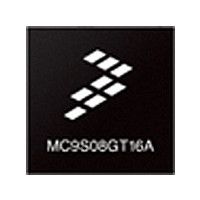MC9S08GT16CFB Freescale Semiconductor, MC9S08GT16CFB Datasheet - Page 196

MC9S08GT16CFB
Manufacturer Part Number
MC9S08GT16CFB
Description
Manufacturer
Freescale Semiconductor
Datasheet
1.MC9S08GT16CFB.pdf
(290 pages)
Specifications of MC9S08GT16CFB
Cpu Family
HCS08
Device Core Size
8b
Frequency (max)
20MHz
Interface Type
SCI/SPI
Program Memory Type
Flash
Program Memory Size
16KB
Total Internal Ram Size
1KB
# I/os (max)
36
Number Of Timers - General Purpose
4
Operating Supply Voltage (typ)
2.5/3.3V
Operating Supply Voltage (max)
3.6V
Operating Supply Voltage (min)
2.08V
On-chip Adc
8-chx10-bit
Instruction Set Architecture
CISC
Operating Temp Range
-40C to 85C
Operating Temperature Classification
Industrial
Mounting
Surface Mount
Pin Count
44
Package Type
PQFP
Lead Free Status / Rohs Status
Not Compliant
Available stocks
Company
Part Number
Manufacturer
Quantity
Price
Company:
Part Number:
MC9S08GT16CFBE
Manufacturer:
FREESCALE
Quantity:
1 831
Company:
Part Number:
MC9S08GT16CFBE
Manufacturer:
Freescale Semiconductor
Quantity:
10 000
Part Number:
MC9S08GT16CFBE
Manufacturer:
FREESCALE
Quantity:
20 000
Company:
Part Number:
MC9S08GT16CFBER
Manufacturer:
Freescale Semiconductor
Quantity:
10 000
- Current page: 196 of 290
- Download datasheet (2Mb)
Serial Peripheral Interface (SPI) Module
12.3.3
There are three flag bits, two interrupt mask bits, and one interrupt vector associated with the SPI system.
The SPI interrupt enable mask (SPIE) enables interrupts from the SPI receiver full flag (SPRF) and mode
fault flag (MODF). The SPI transmit interrupt enable mask (SPTIE) enables interrupts from the SPI
transmit buffer empty flag (SPTEF). When one of the flag bits is set, and the associated interrupt mask bit
is set, a hardware interrupt request is sent to the CPU. If the interrupt mask bits are cleared, software can
poll the associated flag bits instead of using interrupts. The SPI interrupt service routine (ISR) should
check the flag bits to determine what event caused the interrupt. The service routine should also clear the
flag bit(s) before returning from the ISR (usually near the beginning of the ISR).
12.3.4
A mode fault occurs and the mode fault flag (MODF) becomes set when a master SPI device detects an
error on the SS1 pin (provided the SS1 pin is configured as the mode fault input signal). The SS1 pin is
configured to be the mode fault input signal when MSTR = 1, mode fault enable is set (MODFEN = 1),
and slave select output enable is clear (SSOE = 0).
The mode fault detection feature can be used in a system where more than one SPI device might become
a master at the same time. The error is detected when a master’s SS1 pin is low, indicating that some other
SPI device is trying to address this master as if it were a slave. This could indicate a harmful output driver
conflict, so the mode fault logic is designed to disable all SPI output drivers when such an error is detected.
When a mode fault is detected, MODF is set and MSTR is cleared to change the SPI configuration back
to slave mode. The output drivers on the SPSCK1, MOSI1, and MISO1 (if not bidirectional mode) are
disabled.
MODF is cleared by reading it while it is set, then writing to the SPI control register 1 (SPI1C1). User
software should verify the error condition has been corrected before changing the SPI back to master
mode.
12.4
The SPI has five 8-bit registers to select SPI options, control baud rate, report SPI status, and for
transmit/receive data.
Refer to the direct-page register summary in the
assignments for all SPI registers. This section refers to registers and control bits only by their names, and
a Freescale-provided equate or header file is used to translate these names into the appropriate absolute
addresses.
196
SPI Registers and Control Bits
SPI Interrupts
Mode Fault Detection
MC9S08GB/GT Data Sheet, Rev. 2.3
Memory
chapter of this data sheet for the absolute address
Freescale Semiconductor
Related parts for MC9S08GT16CFB
Image
Part Number
Description
Manufacturer
Datasheet
Request
R
Part Number:
Description:
Manufacturer:
Freescale Semiconductor, Inc
Datasheet:
Part Number:
Description:
Manufacturer:
Freescale Semiconductor, Inc
Datasheet:
Part Number:
Description:
Manufacturer:
Freescale Semiconductor, Inc
Datasheet:
Part Number:
Description:
Manufacturer:
Freescale Semiconductor, Inc
Datasheet:
Part Number:
Description:
Manufacturer:
Freescale Semiconductor, Inc
Datasheet:
Part Number:
Description:
Manufacturer:
Freescale Semiconductor, Inc
Datasheet:
Part Number:
Description:
Manufacturer:
Freescale Semiconductor, Inc
Datasheet:
Part Number:
Description:
Manufacturer:
Freescale Semiconductor, Inc
Datasheet:
Part Number:
Description:
Manufacturer:
Freescale Semiconductor, Inc
Datasheet:
Part Number:
Description:
Manufacturer:
Freescale Semiconductor, Inc
Datasheet:
Part Number:
Description:
Manufacturer:
Freescale Semiconductor, Inc
Datasheet:
Part Number:
Description:
Manufacturer:
Freescale Semiconductor, Inc
Datasheet:
Part Number:
Description:
Manufacturer:
Freescale Semiconductor, Inc
Datasheet:
Part Number:
Description:
Manufacturer:
Freescale Semiconductor, Inc
Datasheet:
Part Number:
Description:
Manufacturer:
Freescale Semiconductor, Inc
Datasheet:











